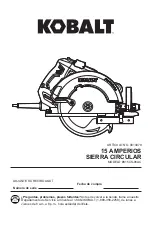
9
SAFETY INFORMATION
• Support larger panels to minimize the risk of blade pinching and kickback.
Larger
panels tend to sag under their own weight. Supports must be placed under the panel on both
sides: near the line of cut and near the edge of the panel.
• Do not use dull or damaged blades.
Dull or improperly set blades produce narrow kerf,
causing excessive friction, blade binding and kickback.
• Blade depth and bevel adjusting locking levers must be tight and secure before
making a cut.
If the blade adjustment shifts while cutting, it may cause binding and kickback.
• Use extra caution when making a “plunge cut” into existing walls or other blind
areas.
The protruding blade may contact hidden objects that can cause kickback.
Safety Instructions for Lower Blade Guard
• Check the lower guard for proper closing before each use. Do not operate the saw
if lower guard does not move freely and close instantly. Never clamp or tie the lower
guard into the open position.
If the saw is accidentally dropped, the lower guard may be
bent. Raise the lower guard with the retracting handle and make sure that it moves freely
and does not touch the blade or any other part, in all angles and all depths of cut.
• Check the operation of the lower guard spring. If the guard and the spring are
not operating properly, they must be serviced before use.
Lower guard may operate
sluggishly due to damaged parts, gummy deposits, or a build-up of debris.
• Lower guard may be retracted manually only for special cuts, such as “plunge cuts”
and “compound cuts.”
Raise lower guard with retracting handle and as soon as blade
enters the material, the lower guard must be released. For all other sawing, the lower guard
should be allowed to operate automatically.
• Always observe that the lower guard is covering the blade before placing the saw
down on the bench or floor.
An unprotected, coasting blade will cause the saw to walk
backwards, cutting whatever is in its path. Be aware of the time it takes for the blade to stop
after switch is released.
Additional Safety Warnings for Circular Saws
a. Only use recommended saw blades with correct size
b. Do not use with any abrasive wheels
c. Always wear a dust mask
d. Always wear hearing protection
PREPARATION
Know Your Circular Saw
This circular saw can be used for the purpose listed: cutting all types of wood and wood
products. Before attempting to use the circular saw, familiarize yourself with all of its operating
features and safety requirements.
WARNING
• Do not allow familiarity with the circular saw to cause carelessness. Remember that one
careless moment is enough to cause severe injury. Before attempting to use any tool, be sure
to become familiar with all of the operating features and safety instructions.
• Do not attempt to modify this tool or create accessories not recommended for use with this
tool. Any such alteration or modification is misuse and could result in a hazardous condition
leading to possible serious personal injury.
























